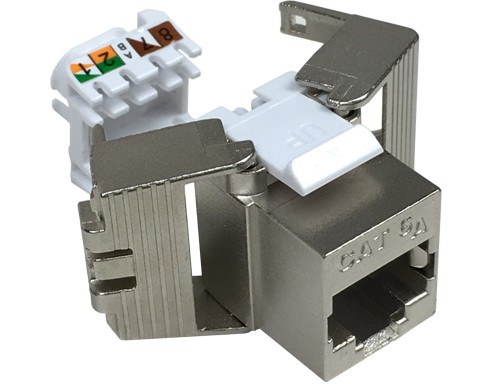Robust and high-speed networking solutions are the foundation of both small and large businesses. One critical component in achieving efficient and reliable network performance is the keystone jack. Among the various options available, the Cat6A UTP Keystone Jacks at DINTEK stand out for their advanced features and compliance with international standards.

This blog will provide an in-depth look at these keystone jacks, their specifications, benefits, and installation process. We’ll ensure you have all the information you need to make an informed decision for your networking needs.
What is a Keystone Jack?
A keystone jack is a standardized snap-in package that allows you to install a range of low-voltage electrical jacks or optical connectors into a keystone wall plate, surface-mount box, and patch panel. These jacks are essential for creating structured cabling systems for data, phone, and video networking.
Understanding Cat6A UTP Keystone Jacks
Specifications and Features
cat6a keystone jack from the D-Link category are designed to support high-speed data transfer rates. This makes them ideal for modern networking environments. Here are some of their standout features:
- RJ45 8P 8C 50U Jacks: These jacks have 8 positions and 8 contacts. They provide a reliable connection for Ethernet cables.
- Compatibility with 22-26 AWG Stranded and Solid Wire: This versatility ensures that these jacks can be used with a wide range of Ethernet cables.
- Supports Both 110 & Krone Punch Down Tools: This dual compatibility makes the installation process more convenient and flexible.
- Universal Labels for T568A and T568B Wiring Schemes: These color-coded labels make it easy to wire the jacks according to the desired scheme.
- High-Density Keystone Patch Panel Compatibility: Designed to fit seamlessly into high-density patch panels, optimizing space and organization.
- Compliance with ANSI/TIA/EIA 568 C.2 & ISO 11801 Standards: Ensuring that these jacks meet international performance and safety standards.
Key Benefits
- Enhanced Performance: Cat6A keystone jacks are designed to handle speeds up to 10 Gbps. This makes them suitable for demanding applications such as data centres, server rooms, and high-speed network backbones.
- Flexibility and Compatibility: The ability to work with both 110 and Krone punch-down tools and support various wire gauges ensures these jacks can be used in a wide range of installations.
- Ease of Installation: Color-coded labels for both T568A and T568B wiring schemes simplify the installation process. It further reduces the likelihood of errors.
- Standards Compliance: Adherence to ANSI/TIA/EIA 568 C.2 and ISO 11801 standards guarantees that these jacks meet industry benchmarks for performance and safety.
Installation Guide for Cat6A Keystone Jacks
Installing Cat6A keystone jacks is a straightforward process, but attention to detail is crucial to ensure optimal performance. Here’s a step-by-step guide:
Tools and Materials Needed
- Cat6A UTP Keystone Jacks
- Cat6A Ethernet Cable
- 110 or Krone Punch Down Tool
- Wire Stripper
- Cable Tester
- Patch Panel (optional)
- Wall Plate (optional)
Step-by-Step Installation
- Prepare the Cable: Strip about 1.5 inches of the outer jacket from the Cat6A cable using the wire stripper, being careful not to damage the inner wires.
- Untwist the Pairs: Untwist the four pairs of wires and arrange them according to the color-coded label for your chosen wiring scheme (T568A or T568B).
- Insert Wires into the Jack: Place each wire into the appropriate slot on the keystone jack, ensuring they are fully seated.
- Punch Down the Wires: Using the punch down tool, press each wire into the slots, cutting off the excess wire. Ensure that the tool is compatible with the type of jack (110 or Krone).
- Test the Connection: Use a cable tester to check for continuity and ensure that there are no wiring errors.
- Mount the Jack: Insert the keystone jack into a patch panel, wall plate, or surface-mount box, depending on your installation requirements.
Applications of Cat6A Keystone Jacks
Cat6A keystone jacks are used in various settings where high-speed and reliable network connectivity is essential. Some common applications include:
- Data Centers: For managing large volumes of data transfer with minimal latency.
- Office Networks: Providing reliable and fast internet access for day-to-day operations.
- Home Networks: Supporting high-speed internet and multimedia streaming.
- Educational Institutions: Enabling seamless connectivity for online learning and administrative functions.
Conclusion
A Cat6A Keystone Jack is a robust and reliable solution for modern networking needs. Its advanced features, ease of installation, and compliance with international standards make it an excellent choice for anyone looking to upgrade or install a new network infrastructure.
Investing in high-quality components like Cat6A keystone jacks not only enhances network performance but also future-proofs your infrastructure against growing data demands. With the right tools and a careful approach, installing these jacks can be a straightforward and rewarding process, ensuring your network operates at its full potential.




